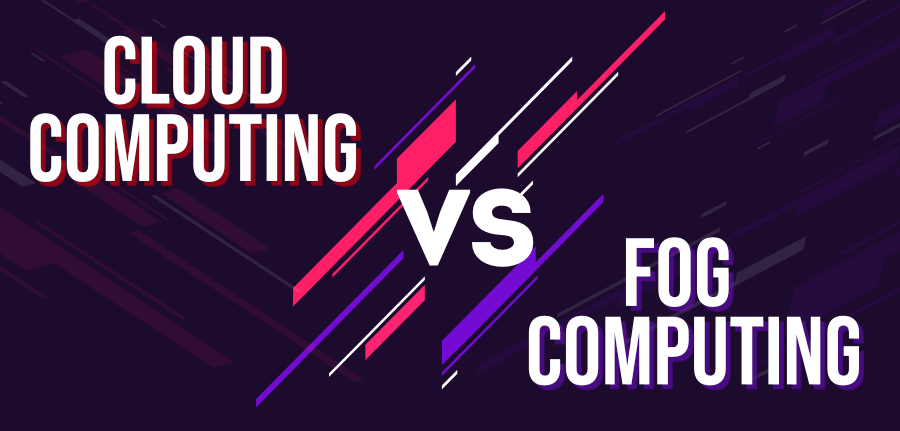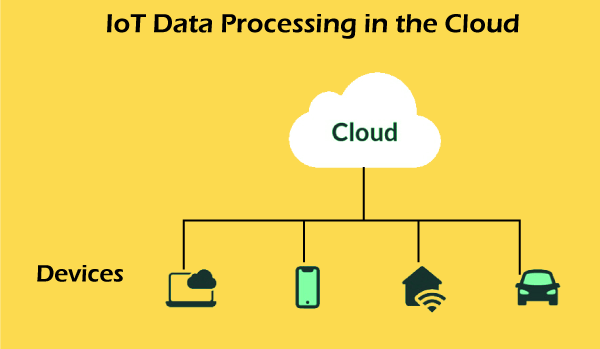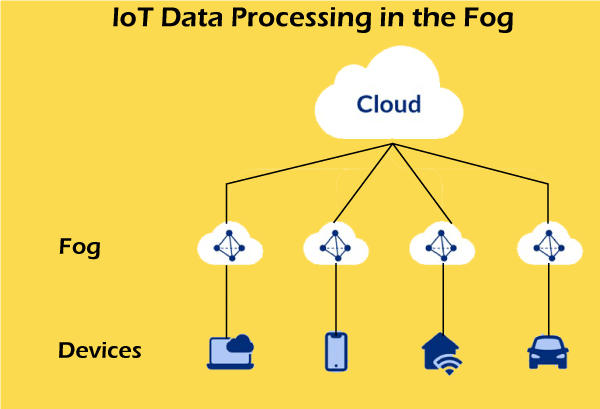Fog computing vs. Cloud computing
Cloud computing: The delivery of on-demand computing services is known as cloud computing. We may use applications to store and process power over the Internet. Without owning any computing infrastructure or data center, anyone can rent access to anything from applications to storage from a cloud service provider.
It is a pay-as-you-go service.
By using cloud computing services and paying for what we use, we can avoid the complexity of owning and maintaining infrastructure.
Cloud computing service providers can benefit from significant economies of scale by providing similar services to customers.
Fog computing is a decentralized computing infrastructure or process in which computing resources are located between a data source and a cloud or another data center. Fog computing is a paradigm that provides services to user requests on edge networks.
Devices at the fog layer typically perform networking-related operations such as routers, gateways, bridges, and hubs. The researchers envision these devices to perform both computational and networking tasks simultaneously.
Although these tools are resource-constrained compared to cloud servers, the geological spread and decentralized nature help provide reliable services with coverage over a wide area. Fog is the physical location of computing devices much closer to users than cloud servers.

Table of differences between cloud computing and fog computing is given below:
| Specialty | Cloud Computing | fog computing |
|---|---|---|
| Delay | Cloud computing has higher latency than fog computing | Fog computing has low latency |
| Capacity | Cloud computing does not provide any reduction in data while sending or converting data. | Fog computing reduces the amount of data sent to cloud computing. |
| Responsiveness | The response time of the system is low. | The response time of the system is high. |
| Security | Cloud computing has less Security compared to Fog Computing | Fog computing has high Security. |
| Speed | Access speed is high depending on the VM connectivity. | High even more compared to Cloud Computing. |
| Data Integration | Multiple data sources can be integrated. | Multiple Data sources and devices can be integrated. |
| Mobility | In cloud computing, mobility is Limited. | Mobility is supported in fog computing. |
| Location Awareness | Partially Supported in Cloud computing. | Supported in fog computing. |
| Number of Server Nodes | Cloud computing has Few numbers server nodes. | Fog computing has a Large number of server nodes. |
| Geographical Distribution | It is centralized. | It is decentralized and distributed. |
| Location of service | Services provided within the Internet. | Services are provided at the edge of the local network. |
| Working environment | Specific data center building with air conditioning systems | Outdoor (streets, base stations, etc.) or indoor (houses, cafes, etc.) |
| Communication mode | IP network | Wireless communication: WLAN, WiFi, 3G, 4G, ZigBee, etc. or wired communication (part of the IP networks) |
| Dependence on the quality of core network | Requires strong network core. | It can also work in a Weak network core. |
Difference between Fog Computing and Cloud Computing:
Information:
- In fog computing, data is received from IoT devices using any protocol.
- Cloud computing receives and summarizes data from different fog nodes.
Structure:
- Fog has a decentralized architecture where information is located on different nodes at the source closest to the user.
- There are many centralized data centers in the Cloud, making it difficult for users to access information on the networking area at their nearest source.
Protection:
- Fog is a more secure system with different protocols and standards, which minimizes the chances of it collapsing during networking.
- As the Cloud operates on the Internet, it is more likely to collapse in case of unknown network connections.
Component:
- Fog has some additional features in addition to the features provided by the components of the Cloud that enhance its storage and performance at the end gateway.
- Cloud has different parts such as frontend platform (e.g., mobile device), backend platform (storage and servers), cloud delivery, and network (Internet, intranet, intercloud).
Accountability:
- Here, the system’s response time is relatively higher compared to the Cloud as fogging separates the data and then sends it to the Cloud.
- Cloud service does not provide any isolation in the data while transmitting the data at the gate, increasing the load and thus making the system less responsive.
Application:
- Edge computing can be used for smart city traffic management, automating smart buildings, visual Security, self-maintenance trains, wireless sensor networks, etc.
- Cloud computing can be applied to e-commerce software, word processing, online file storage, web applications, creating image albums, various applications, etc.
Reduces latency:
- Fog computing cascades system failure by reducing latency in operation. It analyzes the data close to the device and helps in averting any disaster.
Flexibility in Network Bandwidth:
- Large amounts of data are transferred from hundreds or thousands of edge devices to the Cloud, requiring fog-scale processing and storage.
- For example, commercial jets generate 10 TB for every 30 minutes of flight. Fog computing sends selected data to the cloud for historical analysis and long-term storage.
Wide geographic reach:
- Fog computing provides better quality of services by processing data from devices that are also deployed in areas with high network density.
- On the other hand, Cloud servers communicate only with IP and not with the endless other protocols used by IoT devices.
Real-time analysis:
- Fog computing analyzes the most time-sensitive data and operates on the data in less than a second, whereas cloud computing does not provide round-the-clock technical support.
Operating Expenses:
- The license fee and on-premises maintenance for cloud computing are lower than fog computing. Companies have to buy edge device routers.
Fog Computing vs. Cloud Computing: Key Differences
The concepts of Cloud vs. Fog are very similar to each other. But still, there is a difference between cloud and fog computing on certain parameters.
Here’s a point-by-point comparison of fog computing and cloud computing:
- The fog architecture is distributed and consists of millions of small nodes located as close as possible to the client device. The cloud architecture is centralized and consists of large data centers located around the world over a thousand miles away from client devices.
- Fog acts as an intermediary between data centers and hardware and is closer to the end-users. If there is no fog layer, the Cloud communicates directly with the equipment, taking time.
- In cloud computing, data processing takes place in remote data centers. Fog is processed and stored at the edge of the network closer to the source of information, which is important for real-time control.
- Cloud is more powerful than Mist concerning computing capabilities and storage capacity.
- The Cloud consists of some large server nodes. Fog consists of millions of tiny nodes.
- Fog does short-term edge analysis due to the immediate response, while Cloud aims for a deeper, longer-term analysis due to a slower response.
- Fog provides low latency; Cloud provides high latency.
- Without an internet connection, a cloud system collapses. Fog computing uses different protocols and standards, so the risk of failure is very low.
- Fog is a more secure system than Cloud due to its distributed architecture.
The table below helps you better understand the difference between Fog and Cloud, summarizing their most important characteristics.
Benefits of Fog Computing:
- Fog computing is less expensive to work with because the data is hosted and analyzed on local devices rather than transferred to any cloud device.
- It helps in facilitating and controlling business operations by deploying fog applications as per the user’s requirement.
- Fogging provides users with various options to process their data on any physical device.
Benefits of Cloud Computing:
- It works on a pay-per-use model, where users have to pay only for the services they are receiving for a specified period.
- Cloud users can quickly increase their efficiency by accessing data from anywhere, as long as they have net connectivity.
- It increases cost savings as workloads can be transferred from one Cloud to another cloud platform.
Fog Computing vs. Cloud Computing for IoT Projects
According to Statista, by 2020, there will be 30 billion IoT devices worldwide, and by 2025 this number will exceed 75 billion connected things.
These tools will produce huge amounts of data that will have to be processed quickly and permanently. F fog computing works similarly to cloud computing to meet the growing demand for IoT solutions.
Fog is even better on some things. This article aims to compare Fog vs. Cloud and tell you more about Fog vs. cloud computing possibilities and their pros and cons.
We provide leading-edge IoT development services for companies looking to transform their business.
Cloud Computing
We are already used to the technical term cloud, a network of multiple devices, computers, and servers connected to the Internet.
Such a computing system can be figuratively divided into two parts:
- Frontend- is made up of the client device (computer, tablet, mobile phone).
- Backend- consists of data storage and processing systems (servers) that can be located far from the client device and make up the Cloud itself.
These two layers communicate with each other using a direct wireless connection.

Cloud computing technology provides a variety of services that are classified into three groups:
- IaaS (Infrastructure as a Service) – A remote data center with data storage capacity, processing power, and networking resources.
- PaaS (Platform as a Service) – A development platform with tools and components to build, test, and launch applications.
- SaaS (Software as a Service) – Software tailored to suit various business needs.
By connecting your company to the Cloud, you can access the services mentioned above from any location and through various devices.
Therefore, availability is the biggest advantage. Plus, there’s no need to maintain local servers and worry about downtimes – the vendor supports everything for you, saving you money.
Integrating the Internet of Things with the Cloud is an affordable way to do business. Off-premises services provide the scalability and flexibility needed to manage and analyze data collected by connected devices. At the same time, specialized platforms (e.g., Azure IoT Suite, IBM Watson, AWS, and Google Cloud IoT) give developers the power to build IoT apps without major investments in hardware and software.
Advantages of Cloud for IoT
Since connected devices have limited storage capacity and processing power, integration with cloud computing comes to the aid of:
- Improved performance – faster communication between IoT sensors and data processing systems.
- Storage Capacity – Highly scalable and unlimited storage space can integrate, aggregate, and share huge data.
- Processing Capabilities – Remote data centers provide unlimited virtual processing capabilities on demand.
- Low Cost – The license fee is less than the cost of on-premises equipment and its ongoing maintenance.
Disadvantages of Cloud for IoT
Unfortunately, nothing is spotless, and cloud technology has some drawbacks, especially for Internet of Things services.
- High latency – More and more IoT apps require very low latency, but the Cloud cannot guarantee this due to the distance between client devices and data processing centers.
- Downtimes – Technical issues and network interruptions can occur in any Internet-based system and cause customers to suffer from outages; Many companies use multiple connection channels with automatic failover to avoid problems.
- Security and Privacy – your data is transferred via globally connected channels along with thousands of gigabytes of other users’ information; No wonder the system is vulnerable to cyber-attacks or data loss; the problem can be partially solved with the help of hybrid or private clouds.
Fog Computing
Cisco coined the term fog computing (or fogging) in 2014, so it is new to the general public. Fog and cloud computing are intertwined. In nature, Fog is closer to Earth than clouds; In the tech world, it’s the same; Fog is closer to end-users, bringing cloud capabilities to the ground.
The definition may sound like this: Fog is an extension of cloud computing that consists of multiple edge nodes directly connected to physical devices.

Such nodes tend to be much closer to devices than centralized data centers so that they can provide instant connections.
The considerable processing power of edge nodes allows them to compute large amounts of data without sending them to distant servers.
Fog can also include cloudlets – small-scale and rather powerful data centers located at the network’s edge. They are intended to support resource-intensive IoT apps that require low latency.
The main difference between fog computing and cloud computing is that Cloud is a centralized system, whereas Fog is a distributed decentralized infrastructure.
Fog is an intermediary between computing hardware and a remote server. It controls what information should be sent to the server and can be processed locally. In this way, Fog is an intelligent gateway that dispels the clouds, enabling more efficient data storage, processing, and analysis.
It should be noted that fog networking is not a separate architecture. It does not replace cloud computing but complements it by getting as close as possible to the source of information.
There is another method for data processing similar to fog computing – edge computing. The essence is that the data is processed directly on the devices without sending it to other nodes or data centers. Edge computing is particularly beneficial for IoT projects as it provides bandwidth savings and better data security.
The new technology is likely to have the biggest impact on the development of IoT, embedded AI, and 5G solutions, as they, like never before, demand agility and seamless connections.
Advantages of fog computing in IoT
The fogging approach has many benefits for the Internet of Things, Big Data, and real-time analytics. The main advantages of fog computing over cloud computing are as follows:
- Low latency – Fog tends to be closer to users and can provide a quicker response.
- There is no problem with bandwidth – pieces of information are aggregated at separate points rather than sent through a channel to a single hub.
- Due to the many interconnected channels – loss of connection is impossible.
- High Security – because the data is processed by multiple nodes in a complex distributed system.
- Improved User Experience – Quick responses and no downtime make users satisfied.
- Power-efficiency – Edge nodes run power-efficient protocols such as Bluetooth, Zigbee, or Z-Wave.
Disadvantages of fog computing in IoT
The technology has no obvious disadvantages, but some shortcomings can be named:
- Fog is an additional layer in a more complex system – a data processing and storage system.
- Additional expenses – companies must buy edge devices: routers, hubs, gateways.
- Limited scalability – Fog is not scalable like a cloud.
Conclusion:
The demand for information is increasing the overall networking channels. And to deal with this, services like fog computing and cloud computing are used to quickly manage and disseminate data to the end of the users.
However, fog computing is a more viable option for managing high-level security patches and minimizing bandwidth issues. Fog computing allows us to locate data on each node on local resources, thus making data analysis more accessible.
